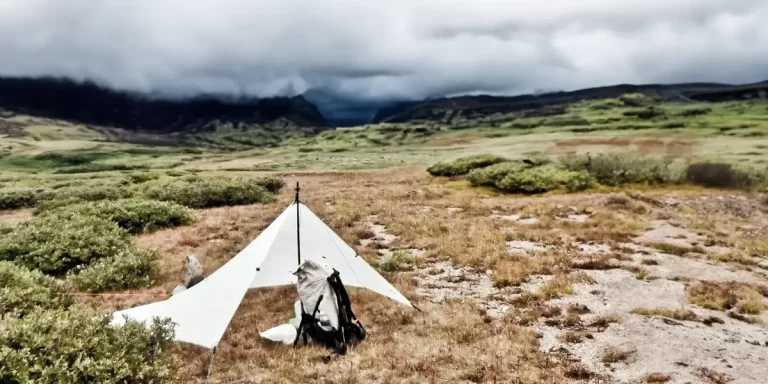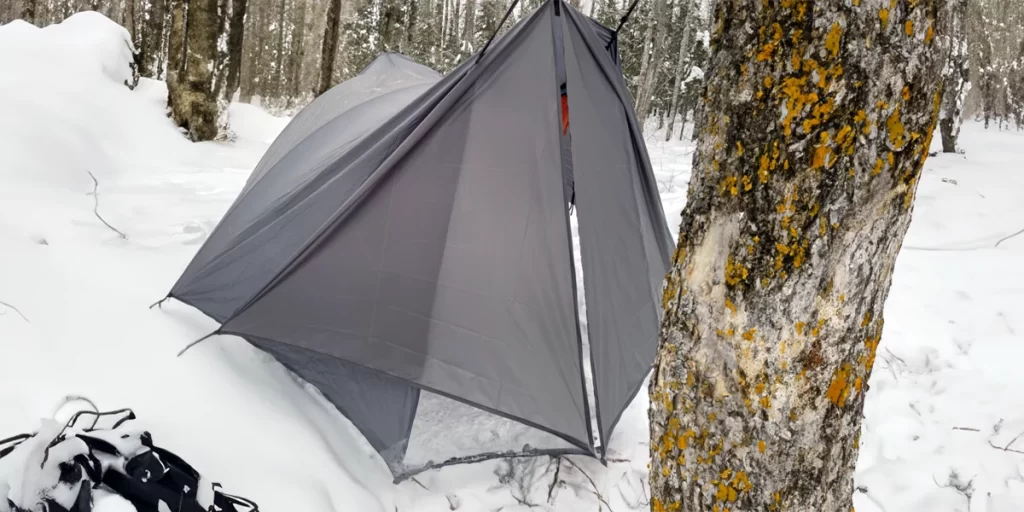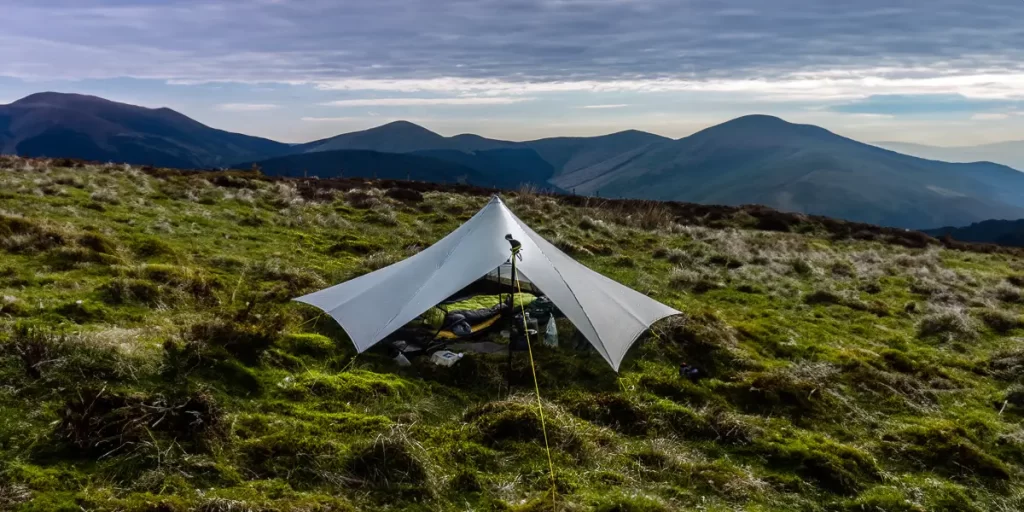

Camping in the rain might seem challenging, but with the right techniques, it is easy. In this post, we’ll delve into the world of tarp camping in rain.
We’ll cover crucial topics such as preventing splashing water, enhancing weather protection with tarp beaks, choosing the ideal campsite, dealing with wet ground, and managing damp gear.
Interested? Let’s get started.
Rain can be quite unpredictable, so when you’re sleeping under a tarp in the rain, it’s crucial to get several things right to ensure a positive experience.
Some of these aspects are directly linked to how you use your tarp, so let’s start by exploring them first.
When tarp camping in the rain, your primary challenge is preventing splash-back – raindrops hitting the ground and soaking you and your gear. Luckily, there are effective methods to stay dry:
1. Pitch Your Tarp Low:
2. Consider about Using a Bivy Sack:

Next, let’s explore the concept of tarp beaks and their role in providing additional weather protection for your shelter during those rainy camping adventures:
Understanding Tarp Beaks:
Tarp beaks are angled overhangs that can be added to the front or rear ends of your tarp. These overhangs serve as extensions, helping to shield you and your gear from rain and wind.
Adding Tarp Beaks:
However, it’s essential to be aware that adding a beak or a full vestibule to your tarp may limit your pitching options. You’ll typically be limited to an A-frame pitch, which might reduce the flexibility of adapting your tarp’s shape to different campsites.

While hiking or backpacking, choosing the ideal campsite is crucial for rain tarp camping. A wrong spot can lead to water pooling and discomfort. Here’s what to consider:
Elevated Mounds and Absorbent Soil:
Proper Drainage:
Mastering the art of campsite selection can greatly improve your tarp camping experience. To dive deeper into this skill, you can explore our dedicated post here.

By incorporating a groundsheet into your tarp camping gear, you’ll be well-prepared to handle wet ground effectively and maintain a dry and comfortable shelter:
The Power of a Groundsheet (Footprint):
If you’re interested in creating your own tyvek groundsheet (which is a bit heavier than polycryo but notably stronger), you can discover a detailed DIY guide here.
Even with the best precautions, it’s not uncommon for gear to get damp or wet when tarp camping in the rain. Let’s see how to deal with it:
The Day-After Drying Routine:
In the pursuit of covering the most miles per day, it’s easy to overlook essential skills like stopping to dry your gear, which are crucial for self-powered outdoor travel.
Consider incorporating gear drying breaks into your daily schedule, especially if dealing with dampness is a recurring issue.
To sum it up, tarp camping in the rain may seem challenging at first, but with the right techniques and understanding, it becomes quite manageable.
Don’t forget to lower your tarp closer to the ground, use tarp beaks, and think about extra gear or a wider tarp for rainy areas. Opt for the right campsite, use a groundsheet for added protection, and take breaks to dry your gear when you can.
With the insights from this post, you’ll not only embrace the challenge of camping in the rain but also thrive in wet conditions, ensuring a memorable and comfortable outdoor experience. Happy camping.
Interested in an ultralight tarp? Check out our TOP 5 guide for the lightest options available.
Rain can potentially permeate a tarp depending on various factors, including the quality and material of the tarp. High-quality tarps made of waterproof materials like coated polyester or nylon resist water effectively, but correct pitching is crucial to prevent leaks. Proper setup involves keeping the tarp tightly stretched and considering its angle in relation to wind and rain direction. Over time, wear and tear can compromise waterproofing, but regular maintenance, including seam sealing and patching, can help. In summary, tarp quality, setup, and maintenance all affect their effectiveness in keeping you dry during wet weather.
When it comes to the best tarp material for rain, there are a few options to consider. Coated polyester and nylon tarps are popular due to their waterproof properties and durability, often featuring polyurethane or silicone coatings for enhanced water repellency. Alternatively, Dyneema Composite Fabric (DCF), also known as Cuben Fiber, is gaining traction, particularly among ultralight backpackers. DCF is prized for its exceptional waterproofing, extreme lightweight nature, and tear resistance. However, it’s worth noting that DCF tarps tend to be pricier compared to traditional coated materials.
When bringing electronics like phones or cameras while tarp camping in the rain, it’s essential to use fully waterproof cases or dry bags, control condensation buildup with canopy extensions, insulate devices from temperature drops, pack backup charging, and bring a drying kit (i.e., a small dry sack or quick-dry towel) for any moisture exposure incidents.
Cooking under a tarp in the rain is possible with the right setup. Choose a durable, waterproof tarpaulin, pitch it low in an A-frame, and use a plastic ground sheet to prevent water pooling. Strategically position your stove for overhead coverage, angle the tarp to divert rain, and bring backups like extra fuel and no-cook meals. If considering a small campfire, place it in the tarp’s vestibule for shelter, but exercise extreme caution.
If you are looking for a jack-of-all-trades solution check out the ProFly™ Rain Tarp by ENO. We’ve found that the performs as advertised. The only drawback so far is that it’s a bit difficult to pack when wet. However, we recommend it due to its easy availability and our confidence in its abilities. Also, note that it comes with four aluminum ground stakes (or pegs), so there’s no need to buy anything extra.